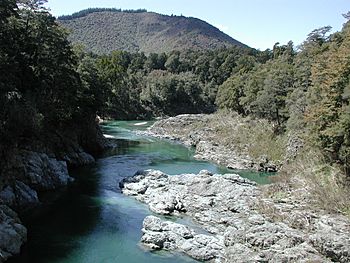Te Hoiere / Pelorus River facts for kids
Quick facts for kids Te Hoiere / Pelorus River |
|
|---|---|

Te Hoiere / Pelorus River from Pelorus Bridge
|
|
| Native name | Te Hoiere |
| Country | New Zealand |
| Region | Marlborough |
| Physical characteristics | |
| Main source | Richmond Range |
| River mouth | Pelorus Sound 41°16′S 173°45′E / 41.267°S 173.750°E |
| Length | 40 km (25 mi) |
| Basin features | |
| Tributaries |
|
The Te Hoiere / Pelorus River is a beautiful river located in the northern part of New Zealand's South Island. It flows through the Marlborough region. The river starts in the Richmond Range mountains and eventually empties into Pelorus Sound.
This area is a popular spot for outdoor activities. Many people enjoy camping and swimming in the river. The Pelorus River is especially famous for its clear waters where it flows through a gorge at Pelorus Bridge.
Fun Facts About the River
A Movie Star River
Did you know the Pelorus River was featured in a famous movie? It was used as a filming location for a scene in The Hobbit: The Desolation of Smaug. This is where the characters escape in barrels down the river! This movie appearance made the area even more popular for river rafting and other water adventures.
Its Special Name
In August 2014, the river's name was officially changed to Te Hoiere / Pelorus River. This dual name honors both its Māori history and its European naming.
River History
The Pelorus River has a rich history. The local Māori originally called it Te Hoiere. This name came from the first canoe that traveled to the South Island. The river flows east until it reaches Pelorus Sound near the town of Havelock.
Long ago, this valley was a significant place for the Ngāti Kuia and Ngāti Apa ki te Rā Tō Māori tribes. Later, in 1838, a European explorer named Lieutenant Chetwode arrived. He was from a ship called HMS Pelorus. He named both the river and the nearby sound after his vessel.
From around 1881 to 1915, a special railway called the Brownlee Tramway operated here. It was used to transport timber from the Carluke Sawmill through the river valley. The timber was then shipped from the port of Blackball in Havelock.

